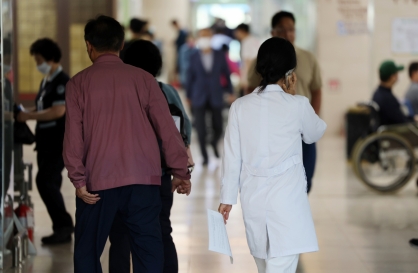Some people complain of pain in the legs while walking that usually goes away a few minutes after rest. And atherosclerosis may be the most common cause.

However, if you are in your 40s or 50s, you need to suspect Buerger’s disease for such leg arterial occlusion.
Buerger’s disease, whose medical name is thromboangiitis obliterans, was given its first accurate pathological description in 1908 by Leo Buerger, a doctor at Mount Sinai Hospital in New York.
The disease is characterized as an occlusion of the small and medium-sized arteries in legs.
It is about five times more common in men than in women. The disease is more common in the Middle East, India, Korea and Japan than in other regions.
Smoking is believed to be the key causative factor of the disease. Smoking is also connected to the disease’s persistence, progression and recurrence.
The disease mainly affects legs, with about 10 percent of prevalence in arms as well.
The initial symptom is cludication, literally limping. A painful, aching, cramping uncomfortable or tired feeling in the legs occurs during walking and is relieved by rest.
As the symptoms get severe, the patient may start to feel pain in the toes and front of the foot at night, which could ultimately lead to ulceration and gangrene.
The disease can be detected by Doppler, duplex ultrasound, CT angiogram or arteriogram.

A Doppler study is a diagnostic tool for early detection. The inspection measures the arterial systolic pressure of ankle (leg) and brachium (arm). The ratio of the ankle index to the brachium is called ankle-brachial index, or ABI.
The normal ABI is usually 1 or greater. An index between 0.5 and 0.8 is considered moderate occlusion and lower than 0.4 indicates severe occlusion.
Duplex ultrasound offers information about lesions and the degree of stenosis and occlusion of arteries.
The symptoms can be relieved largely by quitting smoking. Their progression or recurrence is also closely related to tobacco use.
In a study, 94 percent of Buerger’s disease patients who have stopped smoking avoided amputation of legs or arms, while 43 percent of those who continued to smoke faced amputation.
A wide range of pharmaceuticals such as vasodilator and antiplatelet have been proven to be effective in controlling the disease.
Even though bypass surgery is considered the most effective treatment for atherosclerotic arterial occlusive diseases, its effect in Buerger’s disease is limited as the disease affects a relatively small area and its long-term patency rate is also lower than in atherosclerotic diseases.
Intervention therapies such as balloon angioplasty and stent insertion are also not widely used for Buerger’s disease.
Recently, stem-cell therapy has been considered as an alternative treatment for the future.
The last surgical option in patients with gangrene or ulcers is amputation.
Especially noticeable is that the recovery of a surgical wound is faster in patients who have quit smoking.
If you feel leg cramping while climbing the stairs, Buerger’s disease might be suspected. The final stage of symptoms are gangrene and ulcer of the foot. An early visit to a vascular disease specialist is the only way to prevent amputation.
By Kim Dong-Ik, M.D.
The writer is professor of vascular surgery at Samsung Medical Center, Sungkyunkwan University School of Medicine. ― Ed.

However, if you are in your 40s or 50s, you need to suspect Buerger’s disease for such leg arterial occlusion.
Buerger’s disease, whose medical name is thromboangiitis obliterans, was given its first accurate pathological description in 1908 by Leo Buerger, a doctor at Mount Sinai Hospital in New York.
The disease is characterized as an occlusion of the small and medium-sized arteries in legs.
It is about five times more common in men than in women. The disease is more common in the Middle East, India, Korea and Japan than in other regions.
Smoking is believed to be the key causative factor of the disease. Smoking is also connected to the disease’s persistence, progression and recurrence.
The disease mainly affects legs, with about 10 percent of prevalence in arms as well.
The initial symptom is cludication, literally limping. A painful, aching, cramping uncomfortable or tired feeling in the legs occurs during walking and is relieved by rest.
As the symptoms get severe, the patient may start to feel pain in the toes and front of the foot at night, which could ultimately lead to ulceration and gangrene.
The disease can be detected by Doppler, duplex ultrasound, CT angiogram or arteriogram.

A Doppler study is a diagnostic tool for early detection. The inspection measures the arterial systolic pressure of ankle (leg) and brachium (arm). The ratio of the ankle index to the brachium is called ankle-brachial index, or ABI.
The normal ABI is usually 1 or greater. An index between 0.5 and 0.8 is considered moderate occlusion and lower than 0.4 indicates severe occlusion.
Duplex ultrasound offers information about lesions and the degree of stenosis and occlusion of arteries.
The symptoms can be relieved largely by quitting smoking. Their progression or recurrence is also closely related to tobacco use.
In a study, 94 percent of Buerger’s disease patients who have stopped smoking avoided amputation of legs or arms, while 43 percent of those who continued to smoke faced amputation.
A wide range of pharmaceuticals such as vasodilator and antiplatelet have been proven to be effective in controlling the disease.
Even though bypass surgery is considered the most effective treatment for atherosclerotic arterial occlusive diseases, its effect in Buerger’s disease is limited as the disease affects a relatively small area and its long-term patency rate is also lower than in atherosclerotic diseases.
Intervention therapies such as balloon angioplasty and stent insertion are also not widely used for Buerger’s disease.
Recently, stem-cell therapy has been considered as an alternative treatment for the future.
The last surgical option in patients with gangrene or ulcers is amputation.
Especially noticeable is that the recovery of a surgical wound is faster in patients who have quit smoking.
If you feel leg cramping while climbing the stairs, Buerger’s disease might be suspected. The final stage of symptoms are gangrene and ulcer of the foot. An early visit to a vascular disease specialist is the only way to prevent amputation.
By Kim Dong-Ik, M.D.
The writer is professor of vascular surgery at Samsung Medical Center, Sungkyunkwan University School of Medicine. ― Ed.





![[AtoZ Korean Mind] Does your job define who you are? Should it?](http://res.heraldm.com/phpwas/restmb_idxmake.php?idx=644&simg=/content/image/2024/05/06/20240506050099_0.jpg&u=)












